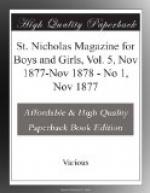Five of them make five, and ooooo-o (five and one) is six, and in that way it runs up to ten. If he wanted to say “twenty” he made a flag, and for forty he made two flags.
Just imagine such a multiplication table as this: Five times four is one flag. Flag times flag is one plume. Flag times plume is one purse! Let’s see; a purse, then, would equal 8,000. Yes, and if he wanted to write 4,000 he would draw only half a purse. All the examples in their arithmetic were worked by such tables as these.
Then there were lessons in time. He had to learn that five days make a week, four weeks make a month, and eighteen months make a year; and as all that footed up only three hundred and sixty days, they threw in what they called the five unlucky days that belonged to no month, to fill up before they commenced a new year. And then he found another arrangement for doing what we do with our leap-year, for, once in fifty-two years they put in twelve and one-half extra days, which is something like setting the clock ahead when you find it is too slow by the town bell or the fire alarm.
[Illustration: MASTER MONTEZUMA MUST BE PUNISHED.]
He learned that this kind of calendar had been in use a long time, and was the result of careful study and calculation by the wise priests of the olden time; and, when he wanted to know how long, he counted up the bundles of reeds which represented centuries, and found that it had been in use over four hundred years. And all this, you must remember, was before San Salvador was discovered by Columbus. Then he had to study all about the naming of the years and the cycles. How, if this year was “one rabbit,” next year would be “two cane,” the third “three flint,” the next “four house,” and these four elements, representing air, water, fire, earth, would be thus repeated up to thirteen, and then they would commence at one again, so that the fourteenth year would be “one cane,” etc., and in four of these cycles of thirteen they would reach a cycle of fifty-two years, or, as they called it, a “bundle,” and as the twelve and one-half days additional would end one cycle of fifty-two years at midday, and the next at midnight, they bundled two of these together and called it “an old age.” The number fifty-two was an unlucky number, and these old Mexicans believed that at the end of a cycle of that number of years, at some time, the world would be depopulated, the sun put out, and, after death and darkness had reigned awhile, it would all begin afresh with a new race of people.
[Illustration: MASTER MONTEZUMA IS TAUGHT HOW TO FISH.]
So, when a cycle or bundle was completed, all fires were extinguished and not rekindled during the five unlucky days. Household goods which could no longer be of any service, dishes, household articles, etc., were broken; every one gave up all hope, and abandoned himself to despair while awaiting the expected ruin.




